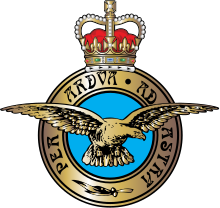
Back Britse Lugmag Afrikaans Royal Air Force AN سلاح الجو الملكي Arabic Royal Air Force AST Kral Hərbi Hava Qüvvələri Azerbaijani Кралски военновъздушни сили Bulgarian রয়্যাল এয়ার ফোর্স Bengali/Bangla Royal Air Force Breton Royal Air Force BS Royal Air Force Catalan
 |
| Royal Air Force of the British Armed Forces |
|---|
| Components |
|
| History and future |
| Aircraft |
| Personnel |
| Organisation |
| Auxiliary services |
The Royal Air Force (RAF) is the air and space force of the United Kingdom, British Overseas Territories and Crown Dependencies.[7] It was formed towards the end of the First World War on 1 April 1918, on the merger of the Royal Flying Corps (RFC) and the Royal Naval Air Service (RNAS).[8] Following the Allied victory over the Central Powers in 1918, the RAF emerged as the largest air force in the world at the time.[9] Since its formation, the RAF has played a significant role in British military history. In particular, during the Second World War, the RAF established air superiority over Nazi Germany's Luftwaffe during the Battle of Britain, and led the Allied strategic bombing effort.[10][11]
The RAF's mission is to support the objectives of the British Ministry of Defence (MOD), which are to "provide the capabilities needed to ensure the security and defence of the United Kingdom and overseas territories, including against terrorism; to support the Government's foreign policy objectives particularly in promoting international peace and security".[12] The RAF describes its mission statement as "... [to provide] an agile, adaptable and capable Air Force that, person for person, is second to none, and that makes a decisive air power contribution in support of the UK Defence Mission".[13] The mission statement is supported by the RAF's definition of air power, which guides its strategy. Air power is defined as "the ability to project power from the air and space to influence the behaviour of people or the course of events".[14]
Today, the Royal Air Force maintains an operational fleet of various types of aircraft,[15] described by the RAF as being "leading-edge" in terms of technology.[16] This largely consists of fixed-wing aircraft, including those in the following roles: fighter and strike, airborne early warning and control, intelligence, surveillance, target acquisition, and reconnaissance (ISTAR), signals intelligence (SIGINT), maritime patrol, air-to-air refueling (AAR) and strategic & tactical transport. The majority of the RAF's rotary-wing aircraft form part of the tri-service Joint Aviation Command in support of ground forces. Most of the RAF's aircraft and personnel are based in the UK, with many others serving on global operations (principally over Iraq and Syria) or at long-established overseas bases (Ascension Island, Cyprus, Gibraltar, and the Falkland Islands). Although the RAF is the principal British air power arm, the Royal Navy's Fleet Air Arm and the British Army's Army Air Corps also operate armed aircraft.
- ^ "4.1 The Royal Air Force logotype". Royal Air Force brand guidelines. Ministry of Defence. December 2005. Archived from the original on 24 September 2024.
- ^ "Our History". www.raf.mod.uk. Royal Air Force. Archived from the original on 24 September 2024.
- ^ a b "Quarterly service personnel statistics 1 January 2024". Retrieved 12 March 2024.
- ^ International Institute for Strategic Studies (15 February 2023). The Military Balance 2023. London: Routledge. p. 128. ISBN 9781032508955.
- ^ "New official RAF Slow March". Royal Air Force. Archived from the original on 30 January 2022. Retrieved 30 January 2022.
- ^ "First Protector aircraft has arrived at RAF Waddington". raf.mod.uk. Royal Air Force. 23 October 2023. Retrieved 9 December 2023.
- ^ "Royal Air Force". Royal Air Force. Archived from the original on 10 September 2017. Retrieved 15 August 2012.
- ^ "RAF Timeline 1918–1929". Royal Air Force. 2011. Archived from the original on 12 August 2012. Retrieved 15 August 2012.
- ^ Air Power and Colonial Control: The Royal Air Force, 1919–1939 Archived 1 January 2016 at the Wayback Machine By David E. Omissi, Published 1 January 1990, Retrieved 1 February 2014. Page 8.
- ^ BBC: Fact File: The RAF Archived 21 April 2015 at the Wayback Machine, retrieved 1 February 2014
- ^ "RAF in the bombing offensive against Germany". Royal Air Force. Retrieved 4 January 2024.
- ^ Cite error: The named reference
RAF – Frequently Asked Questionswas invoked but never defined (see the help page). - ^ "Role of the RAF". Royal Air Force. 2011. Archived from the original on 10 August 2012. Retrieved 15 August 2012.
- ^ "Role of Air Power". Royal Air Force. 2011. Archived from the original on 10 August 2012. Retrieved 15 August 2012.
- ^ Nick Harvey, Minister of State for the Armed Forces (31 January 2012). "Military Aircraft". Parliamentary Debates (Hansard). House of Commons. Archived from the original on 17 September 2017. Retrieved 14 April 2019. "House of Commons Hansard Written Answers for 31 Jan 2012 (Pt 0002)". Archived from the original on 17 September 2017. Retrieved 11 September 2017.
- ^ Royal Air Force: Our high-tech gear Archived 3 February 2014 at the Wayback Machine, retrieved 1 February 2014
Cite error: There are <ref group=lower-alpha> tags or {{efn}} templates on this page, but the references will not show without a {{reflist|group=lower-alpha}} template or {{notelist}} template (see the help page).






